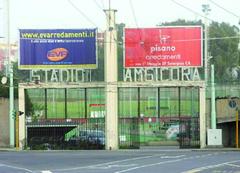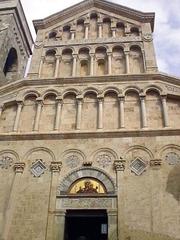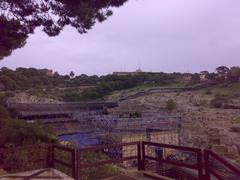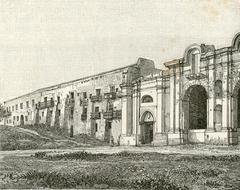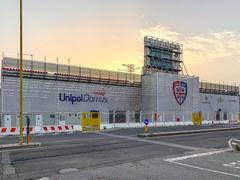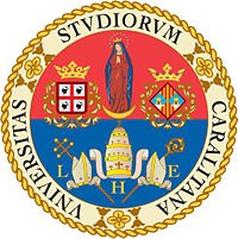National Archaeological Museum of Cagliari: Visiting Hours, Tickets & Comprehensive Guide
Date: 15/06/2025
Introduction
The National Archaeological Museum of Cagliari (Museo Archeologico Nazionale di Cagliari) stands as Sardinia’s foremost cultural and historical institution, offering an immersive exploration of over 7,000 years of the island’s past. Located in the heart of Cagliari within the Cittadella dei Musei complex, the museum is renowned for its extensive collections, modern amenities, and commitment to accessibility. This detailed guide provides essential information on visiting hours, ticketing, collections, accessibility, special events, and nearby attractions, ensuring a rewarding experience for all visitors.
(Strictly Sardinia, Italy by Events, Cagliari Turismo, whichmuseum.com, MARC Official Site)
Table of Contents
- Introduction
- Historical Background
- Museum Layout & Collections
- Visiting Information: Hours, Tickets & Access
- Accessibility & Visitor Amenities
- Special Events & Educational Programs
- Digital Resources & Virtual Tours
- Highlights & Notable Artifacts
- Nearby Attractions
- Travel Tips
- FAQs
- Conclusion
- References
Historical Background
Foundation and Evolution
The National Archaeological Museum of Cagliari was established in the early 20th century, growing from late 19th-century efforts to collect and preserve the island’s archaeological heritage. Originally housed in the Royal Palace, the museum moved to its current home—a renovated former armory—situated in Cagliari’s Cittadella dei Musei. The building, modernized with input from architect Libero Cecchini, now features four floors of state-of-the-art exhibition space, combining historical charm with contemporary design.
(Strictly Sardinia, Wikipedia)
Museum Layout & Collections
Structure & Navigation
The museum’s four floors are organized thematically and chronologically:
- Ground Floor: Introduction to prehistoric Sardinia, including Neolithic tools, pottery, and the earliest evidence of settlement.
- First & Second Floors: Artifacts from the Nuragic, Phoenician, Punic, and Roman civilizations, featuring bronzes, ceramics, jewelry, mosaics, and coins.
- Third Floor: Dedicated to the Giants of Mont’e Prama, iconic stone statues representing the Nuragic civilization.
- Fourth Floor: Hosts temporary exhibitions and special displays.
Clear signage, bilingual Italian-English descriptions, and interactive features support easy navigation for all visitors.
(whichmuseum.com, Cagliari Turismo)
Collection Highlights
- Giants of Mont’e Prama: Monumental Nuragic statues, unique to Sardinia, symbolizing the island’s early artistic and cultural achievements.
- Nuragic Bronzes: Finely crafted figurines depicting warriors, deities, and animals.
- Phoenician & Punic Artifacts: Amulets, ceramics, and the renowned Nora Stone, one of the oldest Phoenician inscriptions in the western Mediterranean.
- Roman & Byzantine Exhibits: Mosaics, coins, and everyday objects illustrating Sardinia’s integration into the Roman Empire.
- Anatomical Wax Models: The Clemente Susini Collection, scientific art masterpieces from the 1800s.
Visiting Information: Hours, Tickets & Access
Opening Hours
- Open: Tuesday to Sunday, 9:00 AM – 7:00 PM (last entry at 6:00 PM)
- Closed: Mondays and select public holidays
- Check: Official website for seasonal updates
Ticket Prices
- Adults: €8–€10 (check official site for updates)
- Reduced: €4–€5 (students, seniors, EU citizens 18–25)
- Children under 18, Cagliari residents, teachers, disabled visitors: Free or nominal fee
- First Sunday of every month: Free entry as part of “Sunday at the Museum”
- Purchase: At museum entrance or online
Location & Directions
- Address: Cittadella dei Musei, Piazza Arsenale 1, Cagliari
- Access: Well connected by city buses, taxis, and within walking distance of central Cagliari. Limited parking available nearby.
Accessibility & Visitor Amenities
- Wheelchair Access: Ramps, elevators, and accessible restrooms throughout the museum.
- Tactile & Sensory Resources: Tactile displays, braille guides, and sensory-friendly programs.
- Multilingual Support: Italian as primary language; some materials and guides available in English and other languages.
- Facilities: Restrooms, café within the museum complex, basic visitor amenities. No cloakroom or lockers—travel light.
- Photography: Allowed without flash in most areas. Check signage for restrictions.
MARC’s award-winning “liquid museum” project earned national recognition for inclusivity, ensuring a welcoming experience for all visitors.
Special Events & Educational Programs
The museum regularly offers:
- Temporary Exhibitions: Rotating displays on the fourth floor
- Workshops & Lectures: For families, students, and adults
- Guided Tours: Available by reservation in multiple languages
- Educational Activities: Interactive experiences for schools and groups
Check the museum’s official website or social media for current schedules and booking information.
Digital Resources & Virtual Tours
- Virtual Galleries: Explore key artifacts and exhibition spaces online.
- Digital Collection Access: Digitized artifacts following Europeana and ICCD standards.
- Audiala App: Download for interactive maps, audio guides, and enhanced visitor resources.
Highlights & Notable Artifacts
- Giants of Mont’e Prama: Iron Age statues representing warriors, archers, and boxers.
- Nora Stone: Early Phoenician inscription, crucial for Mediterranean archaeology.
- Bronzetti: Bronze figurines, unique to Sardinian prehistory.
- Phoenician and Roman Coins: Tracing economic and cultural exchanges.
- Reconstructed Tophet of Tharros: Insight into ancient religious practices.
- Clemente Susini Anatomical Models: Exquisite wax models from the 19th century.
Nearby Attractions
- Cagliari Cathedral
- Bastione di Saint Remy
- Roman Amphitheater
- Santuario & Basilica di Nostra Signora di Bonaria
- Poetto Beach
- Other Museums in the Citadel of Museums
All accessible by foot or public transport, making the museum a convenient part of any Cagliari itinerary.
Travel Tips
- Recommended Visit Duration: 2–3 hours
- Best Times: Weekday mornings or late afternoons to avoid peak crowds
- Advance Booking: Not essential for individuals but recommended for groups and guided tours
- Accessibility Needs: Contact the museum ahead for specific accommodations
- Combine Visits: Explore multiple cultural sites within the Citadel complex
Frequently Asked Questions (FAQ)
Q: What are the museum’s opening hours?
A: Tuesday to Sunday, 9:00 AM to 7:00 PM (last admission 6:00 PM), closed Mondays.
Q: How much are tickets?
A: €8–€10 for adults, with reductions and free entry for eligible categories. Check the official website for updates.
Q: Is the museum accessible?
A: Yes, with ramps, elevators, tactile and sensory resources, and accessible restrooms.
Q: Are guided tours available?
A: Yes, in multiple languages. Booking ahead is recommended.
Q: Can I take photographs?
A: Yes, non-flash photography is permitted in most areas.
Q: Are there facilities for food or rest?
A: Café and restrooms are available within the complex.
Conclusion
The National Archaeological Museum of Cagliari offers a comprehensive journey through Sardinia’s ancient civilizations, from the earliest settlers to the Nuragic era and beyond. Its outstanding collections, inclusive design, central location, and dedication to research and education make it a highlight for any traveler to Cagliari or Sardinia. For the most up-to-date information on tickets, hours, guided tours, and special events, always consult the official museum website.
Plan your visit today, and let the stories of Sardinia’s past inspire your own journey through the heart of the Mediterranean.
Suggested Visuals:
- Museum façade (alt: “National Archaeological Museum of Cagliari entrance”)
- Giants of Mont’e Prama statues (alt: “Giants of Mont’e Prama statues at Cagliari Museum”)
- Interactive map with museum and nearby attractions
- Audiala app interface screenshot
Internal Links Suggestions:
- Articles on Sardinia’s Nuragic civilization
- Guides to other Cagliari museums and historical sites
- Posts about Sardinian festivals and local events
